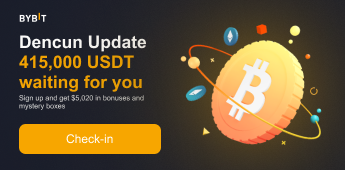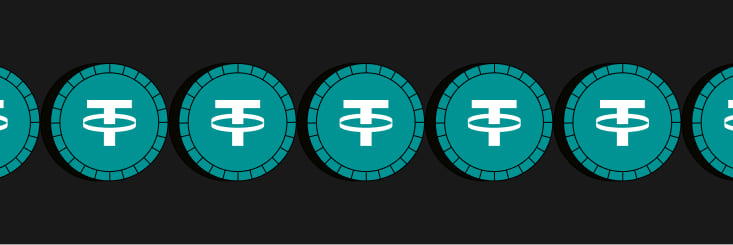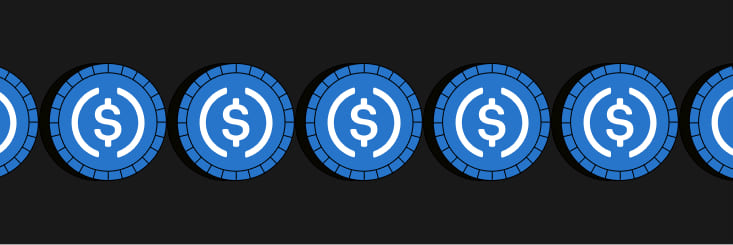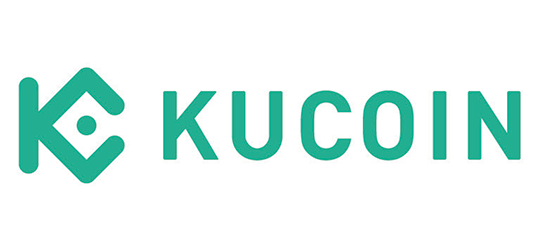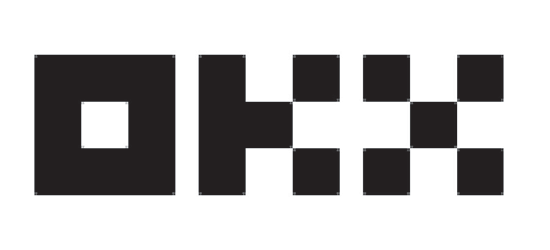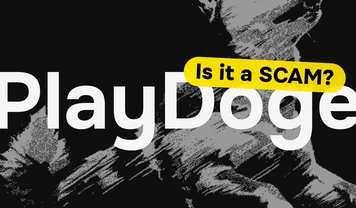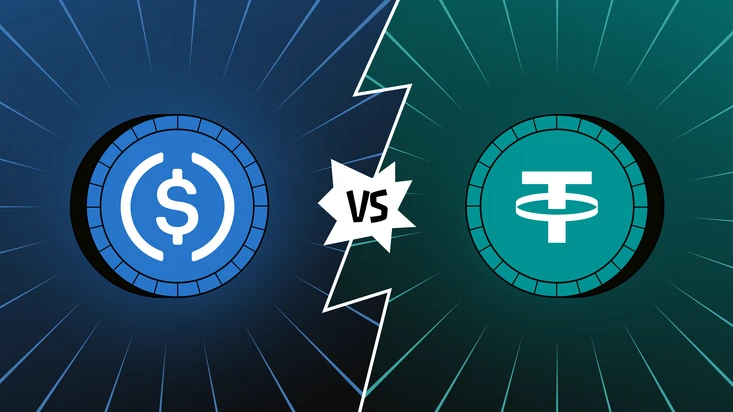
USDC vs. USDT: What Is the Difference?
USDT and USDC are the most dominant stablecoins in the market. What are the differences between Tether vs. USD Coin, and why are they so popular? We will also try to understand if one asset is superior to the other.
What Is the Difference Between USDT and USDC
Before we jump into discussing the differences between USDT and USDC, let's break down what a stablecoin is. A stablecoin is a type of cryptocurrency designed to maintain a stable value, typically by pegging it to the value of a fiat currency like the US Dollar or another stable asset. Stablecoins aim to combine the benefits of cryptocurrencies (such as fast and borderless transactions) with the stability of traditional fiat currencies. Stablecoins come in many forms. For example, fiat-backed, backed by other cryptocurrencies, or algorithmic stablecoins. There are actually a huge variety of stablecoins, but USDC and USDT dominate the market. But why?
Those stablecoins emerged before the others, which is why both USDT and USDC are considered benchmarks. But the increased attention to these assets lies not only there. USDT and USDC are often used as base currencies for trading, providing liquidity to a wide range of cryptocurrency markets. Traders typically use stablecoins as a safe haven during periods of high volatility. Both USDT and USDC are widely accepted across various crypto exchanges, making them convenient choices for trading pairs and liquidity provision. They are issued on multiple blockchain networks, including Ethereum, Tron, and others. This compatibility allows users to transact and move value seamlessly across different platforms.
But if USDT and USDC are the preferred dollar-pegged stablecoins, do they have differences, and what are they? The table below summarizes the differences between the two dominant stablecoins.
| Feature | Tether (USDT) | USD Coin (USDC) |
| Issuer | Tether Limited | Centre Consortium (Coinbase, Circle) |
| Transparency | Historically criticized for lack of transparency and audits | Emphasizes transparency with regular third-party audits |
| Regulatory Compliance | Subject to regulatory scrutiny | Issued by regulated entities, aims for compliance with financial regulations |
| Backing | Claims to be backed 1:1 by fiat currency, but concerns about audits | Backed by a reserve of fiat currency, regularly audited and attested |
| Market Acceptance | Widely used in the cryptocurrency market | Widely accepted, particularly on platforms like Coinbase |
| Use Cases | Trading, liquidity provision, and as a stable store of value | Similar use cases as USDT, including trading and transactions |
| Stability | May be affected by concerns about backing and regulatory issues | Emphasizes regulatory compliance and transparency, perceived as more stable |
| Decentralization | May be criticized for lack of decentralization | Centralized issuance by regulated entities |
| Risk Perception | Some users may perceive higher risk due to historical controversies | Some users may perceive lower risk due to regulatory compliance and transparency |
| Popular Trading Pairs | Commonly paired with various cryptocurrencies | Commonly paired with cryptocurrencies on major exchanges |
Issuer, Transparency and Auditing
Tether is issued by a company called Tether Limited. Tether Limited has faced scrutiny and controversy over the years, particularly related to concerns about the transparency of its reserves and the issuance process. One of the main points of contention has been the claim that each USDT in circulation is backed 1:1 by traditional fiat currency, usually US dollars. Tether Limited has asserted this backing but has been criticized for not providing regular and thorough audits to independently verify the adequacy of its reserves. Tether Limited has released statements and reports, but the absence of consistent, transparent audits has led to ongoing concerns within the cryptocurrency community.
In turn, USD Coin is issued by regulated financial institutions through a consortium known as Centre. The primary entities behind USDC issuance are Coinbase and Circle, both of which are well-established companies in the cryptocurrency space. The involvement of these regulated entities is seen as a strength for USDC, as it provides a level of transparency and regulatory compliance. Furthermore, USD Coin has committed to regular third-party audits to confirm that the circulating supply of USDC is fully backed by a reserve of US dollars. The results of these audits are made publicly available in the form of monthly attestations. Users and market participants can access these reports to verify the reserves and gain confidence in the stability of USD Coin.
The key difference in issuer transparency and regulatory compliance has contributed to varying levels of trust within the cryptocurrency community.
Market Acceptance
Tether (USDT) has been one of the earliest and most widely used stablecoins in the cryptocurrency market. It has achieved significant acceptance across various cryptocurrency exchanges, and many trading pairs are denominated in USDT. Its widespread use contributes to its liquidity and utility in the market. Despite its popularity, Tether has faced controversies, particularly related to concerns about transparency and regulatory compliance. These issues have led some users to approach Tether with caution.
The USDC's acceptance was facilitated by the participation of reputable and regulated organizations in its issuance. The commitment to transparency, regular third-party audits, and regulatory compliance has attracted users who prioritize these factors.
While both Tether and USD Coin are widely accepted stablecoins, the differences in transparency, regulatory compliance, and issuer reputation contribute to varying levels of trust among users. Market acceptance is influenced not only by the convenience of use, but also by factors that instill confidence in the stability and integrity of the stablecoin. Users may choose stablecoins based on their individual preferences, risk tolerance, and considerations regarding the transparency and regulatory compliance of the issuers.
Backing
Tether (USDT) has historically claimed to be backed 1:1 by traditional fiat currency, typically the US Dollar. This means that for each USDT in circulation, there should be an equivalent amount of US dollars held in reserve by Tether Limited. Whether this is the case, no one can say for sure, as Tether is less transparent in its operations than USD Coin.
USD Coin is a fiat-collateralized stablecoin, meaning it is backed by a reserve of fiat currency, in this case, US dollars. The reserves are held in custody by regulated financial institutions. USD Coin emphasizes transparency and regularly undergoes third-party audits. These audits are conducted by reputable accounting firms to attest that the circulating supply of USDC is fully backed by the equivalent amount of US dollars held in reserve.
What is Tether (USDT)?
Tether Limited is the Hong Kong-based company behind the creation and issuance of Tether (USDT), one of the earliest and most widely used stablecoins in the cryptocurrency market. The company was founded in 2014, and its primary purpose is to facilitate the issuance of Tether tokens, which are designed to be pegged to the value of traditional fiat currencies, with the most common peg being the US Dollar.
Tether tokens are issued on various blockchain networks, including Algorand, Avalanche, Ethereum, EOS, Liquid Network, Near, Omni, Polygon, Solana, Bitcoin Cash's Standard Ledger Protocol, Statemine, Statemint, Tezos, and Tron. This multi-platform approach allows users to transact USDT on different blockchain networks.
USDT has a circulating supply of 91.03B coins and a max supply of 91.03B USDT. The backing mechanism is crucial to the stability of Tether. The idea is that for every USDT in circulation, there should be an equivalent amount of fiat currency held in reserve to support its value. This backing is meant to ensure that the value of USDT remains close to the value of the US Dollar. USDT is widely used in the cryptocurrency ecosystem for various purposes. Many crypto exchanges offer trading pairs denominated in USDT. Traders use USDT as a stable medium of exchange and a reference point for valuing other cryptocurrencies. USDT is commonly used for providing liquidity on exchanges and for market-making activities. Traders and investors prefer to use USDT as a stable store of value during times of high volatility in other cryptocurrencies.
What Is a USD Coin (USDC)?
USD Coin (USDC) is a type of stablecoin that is designed to maintain a stable value by being pegged to the value of a traditional fiat currency, in this case, the US Dollar. Each USDC token is intended to represent one US dollar, providing a 1:1 peg to the USD. The primary goal of USD Coin is to offer the benefits of cryptocurrencies, such as fast and borderless transactions, while minimizing the price volatility often associated with other digital assets like Bitcoin and Ethereum.
The issuer of the USDC is Circle that was founded by Jeremy Allaire and Sean Neville in 2013. In the early years, Circle provided a Bitcoin wallet service, allowing users to buy, sell, and store Bitcoin. Over time, Circle shifted its focus to stablecoins and blockchain-based financial services. But USDC is issued through the Centre Consortium, a partnership between Circle and Coinbase. Circle has been proactive in seeking regulatory compliance for its services. The company has worked to ensure that its stablecoin, USDC, is issued and managed in accordance with financial regulations. Therefore, USDC is considered a more reliable and transparent stablecoin than USDT.
The current circulating supply of USDC is 24.78B. USD Coin is issued on various blockchain networks, including Ethereum (as an ERC-20 token), Algorand, Stellar, and others. The multi-platform approach allows users to transact USDC on different blockchain networks. USD Coin is widely used for various purposes within the crypto ecosystem, including trading pairs on exchanges, providing liquidity, and as a stable store of value during periods of high market volatility.
How Stable Are Tether and USD Coin
Both USDT and USDC are fiat-collateralized stablecoins. A fiat-collateralized stablecoin is a type of stablecoin whose value is pegged to the value of a traditional fiat currency, such as the US Dollar, Euro, or another national currency. The stability is achieved by backing the stablecoin with a reserve of the fiat currency held in custody by a trusted financial institution. The basic premise is that for each unit of the stablecoin in circulation, there is an equivalent amount of fiat currency held in reserve. How does it work?
- The issuer of the stablecoin creates and issues tokens on a blockchain or a distributed ledger. These tokens represent units of the stablecoin.
- The issuer holds a reserve of traditional fiat currency (e.g., US dollars) in a bank account or other secure custodial arrangements. The amount in the reserve is intended to match the total supply of stablecoins in circulation. For example, if 1 stablecoin is issued, there should be $1 in reserve.
- To maintain stability, the issuer ensures that the ratio of issued stablecoins to fiat reserves remains constant. If the circulating supply of stablecoins increases, the issuer should increase the amount of fiat currency held in reserve accordingly.
- Users can typically redeem the stablecoin for the equivalent amount of fiat currency from the reserve, and the stablecoin can be issued when users deposit fiat currency to the reserve.
- Issuers of fiat-collateralized stablecoins often commit to transparency and undergo regular third-party audits to verify that the reserves match the circulating supply of stablecoins.
But if the stablecoin is pegged 1:1 to fiat currency, are stablecoins the same as fiat currencies? No, stablecoins and fiat currencies are not the same thing. They have a few key differences. Stablecoins are digital assets that exist solely in a digital environment. Fiat currency is physical cash issued by a central bank. In addition, stablecoins must be backed by something, whereas the value of fiat currency is set by the central bank and is not backed by anything. Another difference is that stablecoins are convenient to use because they are transmitted on the blockchain network. This makes it easy, inexpensive and quick to transfer value overseas. Fiat currency is subject to Central Bank policies, while stablecoins are not subject to such influences, which increases their appeal as a decentralized alternative.
Both USDT and USDC are highly trusted by investors, even though USDT lacks proper transparency. However, one cannot claim that these two assets will remain 100% stable. Yes, they were created as a safe haven in times of high volatility on the cryptocurrency market. Still, in theory, even the most stable assets can suffer. If a stablecoin issuer does not provide sufficient transparency about its reserves or undergoes irregular or inadequate audits, doubts about the stablecoin's backing could arise. This lack of transparency could erode market confidence and impact the stability of the peg. Furthermore, changes in regulatory environments or legal challenges could affect the operations of stablecoin issuers. Regulatory actions, restrictions, or uncertainties may impact the ability of the issuer to maintain the peg. One should not forget about the risk of possible insolvency of the issuer. The issuer's ability to redeem the stablecoin for fiat currency could be compromised, leading to a loss of peg. Also, extreme market events, such as a sudden and severe liquidity crisis, could impact the stability of stablecoins. Market shocks may trigger increased demand for redemptions or disruptions in the usual operations of the stablecoin.
By the way, both Tether and USD Coin has already faced a depegging from the U.S. dollar. In October 2018, USDT fell to $0.92 amid withdrawal issues from cryptocurrency exchange Bitfinex. In 2022, it fell below the dollar twice amid general cryptocurrency market volatility. Meanwhile, the USDC experienced a depegging in the spring of 2023, falling to $0.87 amid the collapse of Silicon Valley Bank (SVB). As it turned out, most of the stablecoin's reserves were in that bank.
It's important to note that stablecoin issuers often take measures to address these risks, such as providing regular audits, ensuring regulatory compliance, and maintaining transparent communication with users. However, users should conduct due diligence, stay informed about the stablecoin issuer's practices, and be aware of the potential risks involved.
FAQ
What are stablecoins?
Stablecoins are a type of cryptocurrency designed to minimize price volatility, typically by pegging their value to a reserve of assets or a stable benchmark. Unlike many other cryptocurrencies, such as Bitcoin or Ethereum, which can experience significant price fluctuations, stablecoins aim to maintain a stable value over time.
Are USDT and USDC the same?
While both Tether (USDT) and USD Coin (USDC) are stablecoins pegged to the value of the US Dollar, there are some key differences between them. Tether is issued by a company called Tether Limited. USD Coin is issued by regulated financial institutions, primarily by Coinbase and Circle. Tether is less transparent than USD Coin.
Is USDT safe?
The safety of using Tether (USDT) has been a topic of discussion and scrutiny within the cryptocurrency community. While Tether has claimed to be backed 1:1 by US dollars, concerns have been raised about the lack of regular and thorough audits to independently verify these claims. Tether has faced regulatory scrutiny from various authorities. Tether is one of the most widely used stablecoins in the cryptocurrency market, and it is commonly used for trading and liquidity on various exchanges. The fact that it is widely accepted in the crypto ecosystem contributes to its utility. It's important for users to conduct their own research, understand the risks, and consider their individual preferences and risk tolerance when using any stablecoin, including Tether.
Is USDC safer than USDT?
The perception of whether USD Coin (USDC) is safer than Tether (USDT) often centers around factors such as transparency, regulatory compliance, and the reliability of the stablecoin's backing. Considering these factors, USDC outperforms USDT in safety. Nevertheless, research of its own is needed.
Is USDC a good investment?
USD Coin (USDC) is not typically considered an investment in the traditional sense, as it is a stablecoin designed to maintain a stable value pegged to the US Dollar. USDC is commonly used for various purposes within the cryptocurrency ecosystem, including: trading pairs, stable value storage, facilitated transfers and payments.
How to buy (and sell) USDT and USDC?
Buying and selling Tether (USDT) and USD Coin (USDC) can be done through various cryptocurrency exchanges. Choose the desired cryptocurrency exchange, create an account, fund your account, go to the trading section with USDT or USDC, place an order. To sell USDT or USDC, go to the trading page and place the trade order.
Jeremy Allaire Bitfinex Ledger




